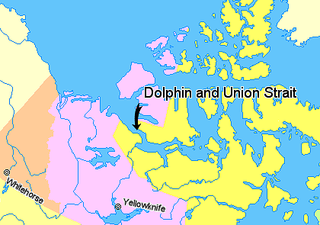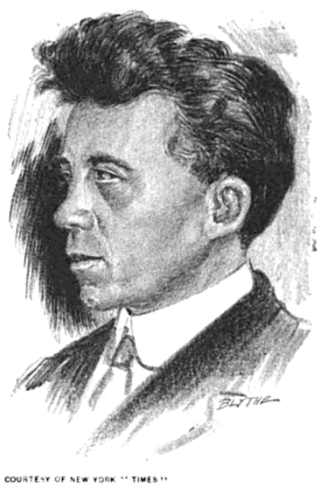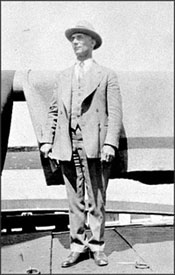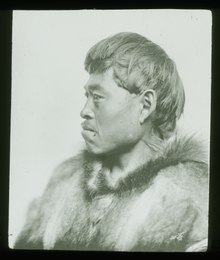
Vilhjalmur Stefansson was an Arctic explorer and ethnologist. He was born in Manitoba, Canada.

The last voyage of the Karluk, flagship of the Canadian Arctic Expedition of 1913–16, ended with the loss of the ship in the Arctic seas, and the subsequent deaths of nearly half her complement of 25. In August 1913, Karluk, a brigantine formerly used as a whaler, became trapped in the ice while sailing to a rendezvous point at Herschel Island. After a long drift across the Beaufort and Chukchi seas, in January 1914 the ship was crushed and sunk. In the ensuing months, the crew and expedition staff struggled to survive, first on the ice and later on the shores of Wrangel Island. In all, eleven men died before rescue. The Canadian Arctic Expedition was organised under the leadership of Canadian anthropologist Vilhjalmur Stefansson, and had both scientific and geographic purposes. Shortly after Karluk was trapped, Stefansson and a small party left the ship, stating that they intended to hunt for caribou. However, the ice carried Karluk westwards, far from the hunting party who found it impossible to return to the ship. Stefansson reached land and then devoted himself to the expedition's scientific objectives, leaving the crew and staff on board the ship under the charge of its captain, Robert Bartlett. After the sinking, Bartlett organised a march across the ice to Wrangel Island, 80 miles (130 km) away. Conditions were difficult and dangerous; two four-man parties were lost before the island was reached.

Diamond Jenness, was one of Canada's greatest early scientists and a pioneer of Canadian anthropology.

Dolphin and Union Strait lies in both the Northwest Territories and Nunavut, Canada, between the mainland and Victoria Island. It is part of the Northwest Passage. It links Amundsen Gulf, lying to the northwest, with Coronation Gulf, lying to the southeast. The southeastern end of the strait is marked by Austin Bay. It gets its name from the two boats used by the Scottish naval surgeon and explorer John Richardson, who was the first known European to explore it in 1826.
Gísli Pálsson is a Icelandic anthropologist, born in 1949 in Vestmannaeyjar, Iceland. He was a professor of anthropology at the University of Iceland until his retirement in 2019. He is currently holding the Professor Emeritus title in the anthropology Department at the university of Iceland. Gísli has published works in the fields of Social Anthropology, Environmental Anthropology and Molecular Anthropology.

Copper Inuit, also known as Kitlinermiut and Inuinnait, are a Canadian Inuit group who live north of the tree line, in what is now the Kitikmeot Region of Nunavut and in the Inuvialuit Settlement Region in the Inuvik Region of the Northwest Territories. Most of them historically lived in the area around Coronation Gulf, on Victoria Island, and southern Banks Island.
The Rae River (Pallirk) is a waterway that flows from Akuliakattak Lake into Richardson Bay, Coronation Gulf. Its mouth is situated northwest of Kugluktuk, Nunavut. Its shores were the ancestral home of Copper Inuit subgroups: the Kanianermiut and the Pallirmiut.
Albert Edward Bay is a bay on the southeast side of Victoria Island in the Arctic Archipelago. It faces Victoria Strait to the east. There are several islands in the bay, the largest of which is Admiralty Island at its mouth. Its north side is the Collinson Peninsula.
Ahiagmiut were a geographically defined Copper Inuit subgroup in the northern Canadian territory of Nunavut. They were located near Ogden Bay, on the Queen Maud Gulf, and inland towards Back River, then on towards the Akilinik River.
Akuliakattagmiut were a geographically defined Copper Inuit subgroup in the Canadian territory of Nunavut. They were located near Cape Bexley on the south shore, mainland side of Dolphin and Union Strait, and in the vicinity of the Melville Hills' Akuliakattak Lake, the source of the Rae River.
The Ekalluktogmiut were a geographically defined Copper Inuit subgroup in Canada's Nunavut territory. They were located along the Ekalluk River near the center of Victoria Island, Albert Edward Bay in western Victoria Strait, and Denmark Bay. According to the Arctic explorer Vilhjalmur Stefansson, the Ekalluktogmiut winter hunt on Dease Strait.
Haneragmiut were a geographically defined Copper Inuit subgroup in the Canadian territory of Nunavut. They were the most westerly band of those that hunted in southern Victoria Island. They were generally located on the north shore of Dolphin and Union Strait, north of Cape Bexley, and south of Prince Albert Sound, on Victoria Island. Though they migrated seasonally both north and south for hunting, fishing, and trade, they were unaware that Victoria Island was an island.
Kogluktogmiut were a geographically defined Copper Inuit subgroup in the Canadian territory of Nunavut. They were located by Bloody Falls, a waterfall on the lower course of the Coppermine River in the Kugluk/Bloody Falls Territorial Park, notable for the Bloody Falls Massacre.
Sutton Island is located in northern Canada's territory of Nunavut. It is situated in the Dolphin and Union Strait immediately next to Liston Island. Rymer Point and Simpson Bay, on Victoria Island's Wollaston Peninsula are to the northeast. Bernard Harbour, on the mainland, is to the southwest, as is Chantrey Island.

The Kangiryuarmiut are an Inuvialuit group, culturally and historically related to the Copper Inuit. They were historically located on Victoria Island in the areas of Prince Albert Sound, Cape Baring, and central Victoria island. They often travelled seasonally around their traditional territory including to Banks Island, both south to Nelson Head and as far north as Mercy Bay to collect raw materials from the wreck of the HMS Investigator. Archaeologists have also found many sites left by Kangiryuarmiut and their ancestors in what is now Aulavik National Park. Today, many Kangiryurmiut still live on Victoria Island, in the hamlet of Uluhaktok, now within the Inuvialuit Settlement Region.
The Ugyuligmiut were a geographically defined Copper Inuit band in the Canadian Arctic's Northwest Territories. They were located on Victoria Island north of Minto Inlet, and on Banks Island in the Aulavik National Park region.
Pallirmiut were a geographically defined Copper Inuit group in the Canadian Arctic territory of Nunavut. They were located by the mouth of the Rae River (Pallirk) during the spring. Some stayed there during summers, while others joined the Kogluktogmiut at the Bloody Falls summer salmon fishery. Pallirmiut wintered on west central Coronation Gulf, and went inland when the snow was gone, carrying packs rather than using sleds.

The Canadian Arctic Expedition 1913–1916 was a scientific expedition in the Arctic Circle organized and led by Vilhjalmur Stefansson. The expedition was originally to be sponsored by the (US) National Geographic Society and the American Museum of Natural History. Canada took over the sponsorship because of the potential for discovery of new land and Stefansson, who though born in Canada was now an American, re-established his Canadian citizenship. The expedition was divided into a Northern Party led by Stefansson, and a Southern Party led by R M. Anderson.
The Kilusiktogmiut were a Copper Inuit subgroup. They lived on Victoria Island, east of the Nagyuktogmiut who were known to inhabit the area northeast of Lady Franklin Point. They also lived on the mainland along the Coronation Gulf, particularly at the mouth of the Mackenzie River. They spent at least some time on the Banks Peninsula by Bathurst Inlet.

Christian Klengenberg Jorgensen, was a Danish whaler, trapper, and trader, active for 34 years in Alaska and Northern Canada. He is notable for opening trade routes to the Copper Inuit territory. Klengenberg is also credited with the discovery of Blond Eskimo and recounting his experience to the anthropologist Vilhjalmur Stefansson who went on to publish about their existence.








